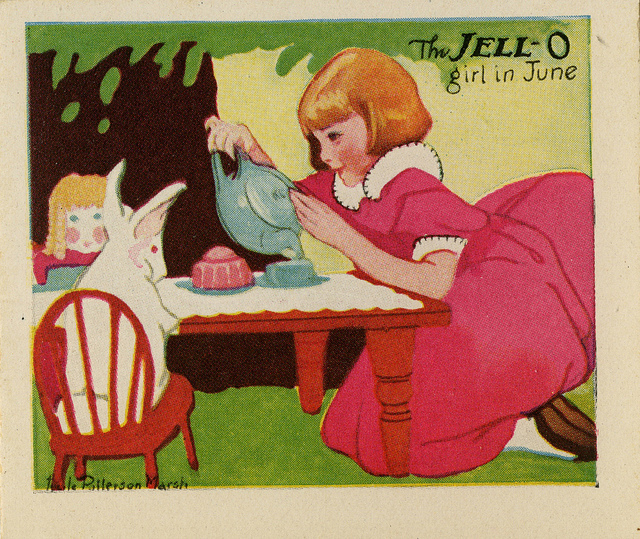This is the story of Jell-O - a cheap and easy-to-make gelatin-based dessert product. There were other competitors that came before Jell-O that had basically the same product of powdered gelatin in a package with flavoring added to it, but Jell-O made gelatin desserts popular at a time when gelatin desserts were unfamiliar to the masses. Right into the mid 1800s, gelatin dishes were only eaten by the elite wealthy families who had huge kitchens, and cooks who could spend the time to laboriously boil down animal parts to get gelatin. So gelatin desserts were new to many people, and it took a lot of powerful advertising to make gelatin dishes a well-known dessert. Jell-O accomplished this advertising feat where others failed.
![Original oil painting Original oil painting [Courtesy of Jell-O Gallery]](/images/Episode_images/oilpainting1.png)
In the town of Le Roy, where the Jell-O brand was first conceived, there is a museum, called the Jell-O Gallery Museum, where you can see some of the original advertising art. When the Jello factory in Le Roy was closed in 1964, 19 original oil paintings were donated to the historical society, which opened the Jell-O Gallery Museum in 1997 to celebrate the 100th anniversary of the introduction of Jell-O in 1897.
So to tell this story, we called up Lynne Belluscio - the director of the Le Roy Historical society and the curator for the Jell-O Gallery Museum.
As Lynne explained to us, the Jell-O story really begins in 1897. In that year, Pearle Bixby Wait decided to package powdered gelatin, together with sugar, flavor, and color. His wife suggested the name "Jell-O". Pearle and May did not patent their Jell-O recipe, because there were other flavored gelatins on the market (for example, Tryphosa and Knox gelatin) but they trademarked the name “Jell-O”. For 2 years, Pearle Wait tried to market Jell-O. Pearle was not successful at marketing it so he ended up selling the right to use the name “Jell-O”. He sold the rights to Orator Frank Woodward, who was the owner of the Genesee Pure Food Company. For $450, Woodward got the right to use the name “jello” and all the surplus boxes of jello that Pearle Wait had left. This was in 1899.
![Original oil painting Original oil painting [Courtesy of Jell-O Gallery]](/images/Episode_images/oilpainting2.png)
Some Great Marketing
Although Orator Woodward was a successful businessman, he also had a hard time marketing Jell-O. His solution was to do a ton of advertising. He placed ads in magazines and he got salesmen to go into towns with a wagon of recipe books using Jell-O. His salesmen handed out the recipe books for free and then went to shopkeepers to let them know that a lot of people would be looking to buy Jell-O. This worked really well. People were happy to try the making the colorful and affordable dishes in the recipes.

So, this was genius enough, but there was another element to this sales plan. Because Orator Woodward’s salesmen did not go selling the product door-to-door, they didn’t have to have traveling salesmens’ licenses, which cost money - you have to buy it in each town if you want to sell door to door. To save the money, he even gave his salesmen a little booklet that told them legally what to do when they got into a town if they were confronted with someone telling them “you need a traveling salesmens’ license". His salesmen could respond "we're not selling door to door.” Orator Woodward’s traveling salesmen were very successful in getting people to go to the store and ask for Jell-O, but the name became so well known that asking for Jell-O was practically synonymous with asking for any gelatin package.
So Orator Woodward worked hard to protect the brand name through advertising. For example, 4 year old Elizabeth King was introduced as the Jell-O Girl in 1904. Not long after, Orator Woodward died of a stroke in 1906, but his family took over, and continued to be successful. By 1907, Jell-O was grossing a million dollars a year.
Special Thanks to Our Interviewee:
Lynne Belluscio - Director of the Le Roy Historical Society and the curator for the Jell-O Gallery Museum

